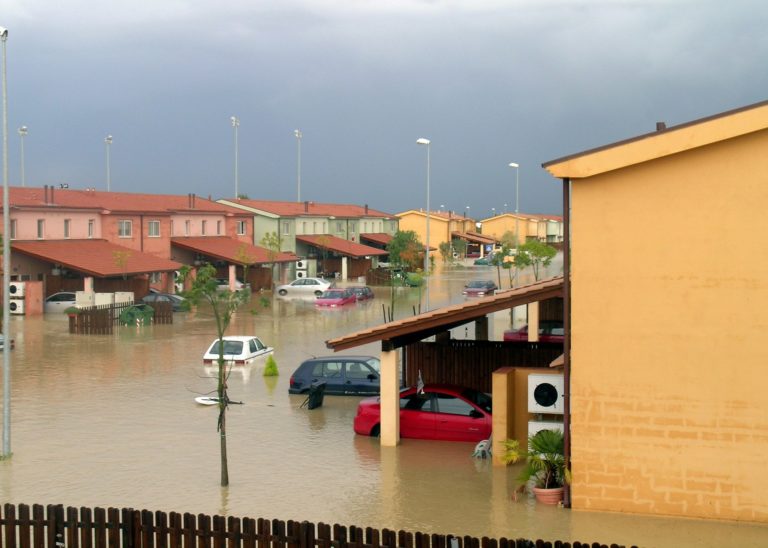Mother nature recently put on a demonstration of its destructive force when Storm Eloise made landfall over Mozambique and surrounding areas of South Africa. The devastating tropical Storm left a number of areas completely flooded, resulting in millions of rands worth of damage.

The damaged a flood can cause on a small town.
To help prevent any property damage and avoid injury or loss of life in the event of any further tropical storms, Dialdirect Insurance has formulated a set of guidelines and rules to follow for when mother nature decides to put on another destructive display of force.
Heavy Rain:
-Standing firm: Make sure that your outdoor furniture and accessories are safely stored or firmly secured and ensure that all gates and doors are properly locked.
-Standing firm: Heavy rains are often associated with lightning. It’s best to have surge protection plugs in place and/or to unplug appliances before the storm makes landfall.
-Under cover: Where possible, park your car under a cover and delay travelling until the storm has subsided. If you are caught in a heavy storm and you feel it’s not safe to drive, look for cover, pull over and/or seek shelter. This could include a covered car park, a petrol station or under a bridge. Don’t park under trees as there is a danger of falling branches and debris.
-Take extreme care when pulling-over, put on your hazard lights, and don’t risk your safety or the safety of others by dashing madly for cover.
Floods:
-Sand savvy: It is sensible to purchase your own supply of sandbags, especially if you live in a flood-prone area. These can be placed against doorways and low-level vents in times of flooding to help minimise the amount of water that enters your home.
-High value, higher up: Move high-value items to the highest possible floor or shelf if a flood threatens.
-Flip the switch: Turn off electricity and gas supplies if flooding occurs to limit the risk of electrical shock or fire.
-Make the call NOW: If you see warning signs like water seeping through the door or water eating away at your home’s walls and foundations, it’s best to head for higher ground immediately. Do not wait for it to become a life-threatening crisis before deciding to find a new location.
-Cars don’t swim: Motorists should not attempt to drive in flood conditions. Remember that just 15cm of moving water can knock you off your feet and water just 60cm deep can sweep a vehicle away. You also run the risk of flooding your vehicle’s air intake, which will stall the engine. Generally, if the water is deeper than the bottom of your doors or the bottom third of your wheels, it is not advisable to drive through it.
-High alert for low-lying spots: Flash flooding often occurs when rivers flow over low-lying bridges. Avoid crossing bridges or roads next to rivers during heavy rains. If you do get stuck on a flooded road, switch to the lowest possible gear and proceed slowly.
-Easy does it: If you approach a flooded spot at speed, it is advisable to take your foot off the accelerator and let your speed drop gradually. Never use the brakes suddenly because this may cause the car to skid or aquaplane.
-Bail out: If your vehicle gets stuck during flooding, or starts to get washed away, rather abandon the vehicle and get to higher ground. It is dangerous to try and drive out of the water to safety.
Hail:
-Structurally sound: If you are in an area prone to heavy hail, make sure that the structures around your home can handle the extra weight, and that you are equipped to clear any build-ups as need be. Reinforce structures where necessary.
-Wait it out: If there is no shelter nearby, motorists are urged to pull-over onto the side of the road if it is safe to do so. In an unsheltered spot, hail damage is inevitable but, it is safer not to drive through a storm when visibility is poor, the roads are slick and there is a risk of aquaplaning through deep pools of water and ice.
-Bolstering with blankets: Another idea is to keep heavy blankets in your car. This will provide you with a protective covering you can throw over the bonnet of your car to prevent hail damage.
General rules to remember:
-Regular home maintenance: Checking structures around your house for weak spots, clearing debris from gutters, fastening items that could become deadly projectiles, cutting away dead trees and branches and ensuring adequate drainage, is essential and will significantly reduce your risk.
-Good vehicle maintenance: Make sure that your vehicle is in tiptop shape and won’t let you down, even when the proverbial ‘high water’ comes.
-Eye on the weather: Always keep an eye on the weather forecast and look out for warnings of heavy rains and high winds. Avoid dangerous areas where possible.
-SOS on speed dial: Make sure to have all emergency numbers, including that if your insurer, saved on your phone or memorised. Make sure that your whole family is thoroughly briefed on what to do and who to call in an emergency.
‘Storms like Eloise are a display of nature’s power. They can however quickly escalate into a full-blown disaster,’ said Bianca De Beer from Dialdirect Insurance in a statement.
‘It’s wise to remember that your life and those of your loved ones are worth more than any house or car, so don’t risk it at any cost. Also ensure that, in the event that disaster does strike, you have adequate insurance in place to cover the complete repair or replacement cost of your house, vehicle and other possessions,” De Beer added.
Picture: Pixabay
















